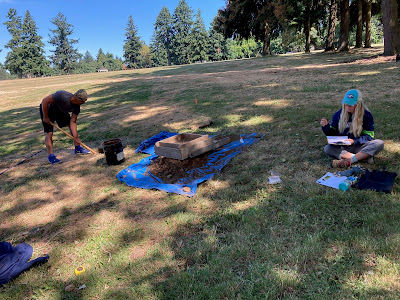Searching for the Pond
As Sandra notes, we are nearing the end of the two 1 X 2-meter test units we placed in the area of the pond. It has been a long slog through railroad fill placed sometime after 1907 with an occasional rotted post or voids left from removal of the pilings for the original train trestle. A few railroad spikes have been recovered but not much more. As Daniela Ortiz, a Portland State University student, quoted from an old archaeological adage: "It’s not what you find, it’s what you find out!"
Elsewhere, we have been working through layers of Army-era fill at the waterfront. We are beginning to find some fur trade era objects and maybe even a few belongings from the indigenous people who lived along the Columbia River before the fur trade, likely ancestral Chinook people.Elsewhere, students are learning how to find sites in the park area just south of the Visitor Center. Students learn how to walk transects, use a compass to stay on bearing, and how to record sites that they might find. The latter part of their week on survey is excavation of subsurface "probes" that are small cylindrical or cone-shaped excavations that are designed to see if an archaeological site is present. In the western portions of the Pacific Northwest, these probes are one of the most common activities for archaeologists as the ground surface is usually not visible under the heavy turf, undergrowth, and forest duff.
The third part of the field school is the field laboratory where students learn how to troubleshoot field recording, clean and process the artifacts to get them ready for analysis. A portion of this week is also recording grave monuments in the Old City Cemetery. A long-term project that is designed to collect information on the markers while monitoring them for vandalism, and other damage caused by natural elements.Daniela Ortiz, reports: The lab and cemetery crew recorded gravestone information onto iPads. Creating a record of the information is helpful in the event a gravestone is vandalized or becomes illegible due to exposure of the elements." Tulane University student Jacob Cobb is shown recording gravestone data. Jacob is taking the course through Washington State University Vancouver.




Comments
Post a Comment